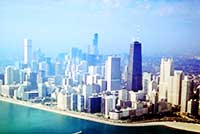Sep 30 2008
Although the industrial compounds known as polychlorinated biphenols or PCBs have been found in previous air samples collected in the city of Chicago, a University of Iowa researcher says that a new study of Chicago air sampled between November 2006 and November 2007 found PCB11, a byproduct of the manufacture of paint pigments and a potentially toxic substance, present throughout the city.

"To the best of our knowledge, this is the first published report of PCB11 in ambient air," said Keri Hornbuckle, UI professor of civil and environmental engineering, in the Sept. 24 online issue of the journal Environmental Science & Technology. The journal can be found at http://pubs.acs.org/journals/esthag/.
"This compound is ubiquitous in air throughout the city of Chicago," said Hornbuckle, who is also a researcher at the renowned Iowa research institute IIHR-Hydroscience and Engineering.
"We do not know if there are any health concerns associated with this compound but there are very few published studies of its toxic properties," she said.
To conduct the test, UI researchers mounted air sample collection devices on platforms attached to the rear of two medical clinic vans provided by the Mobile C.A.R.E. Foundation of Chicago (Comprehensive Care for Chicagoland's Children with Asthma). The samples were collected during the six to eight hours each day that the vans visited sites, primarily elementary schools, where the mobile clinics provide service to students and their families.
In all, researchers found PCB11 in 91 percent of the 184 samples collected.
Regarding the possible source of the substance, Hornbuckle and her UI colleagues Dingfei Hu and Andres Martinez reported, "The wide distribution of PCB11 in Chicago air is consistent with volatilization of this compound from painted surfaces although the actual source of PCB11 is unknown."
Historically, PCB11 is one of 209 compounds manufactured between the late 1920s and the 1970s. The report noted that they were primarily marketed as mixtures called Aroclors by chemical companies until U.S. production ceased in the late 1970s. The distribution of PCB11 throughout residential areas of Chicago suggests that the compound is a past or current component of consumer paint products.
The report also said that the historical trend for PCB11 is unknown and probably different from that for Aroclors -- particularly if PCB11 is produced as a by-product of current paint manufacturing -- and that Aroclor-PCBs in the environment are decreasing worldwide, but this may not be the case for PCB11.
The prevalence of PCB11 in Chicago air suggests that there are either multiple current sources in the city or that this compound is ubiquitous in background air. This has important implications for human exposure to this potentially toxic compound, according to the study.
"While inhalation is not widely considered to be a major exposure route for higher molecular weight PCBs, it may be an important route for PCB11," Hornbuckle said. "Not only is PCB11 one of the most volatile PCBs, if it is present in interior paints, then indoor concentrations may be much higher than reported here."
Concluding that further study is needed, Hornbuckle and her colleagues said "Consumption of paint chips could be also a direct exposure route for children. It is also possible that PCB11 is present not only in Chicago, but in air elsewhere and also in fish, soil, water, food and humans."